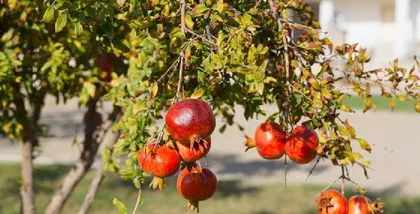The pomegranate tree is a common fruit tree variety, and its fruit is delicious, nutritious, and widely loved. However, many people believe that pomegranate trees can only be planted in rural areas or orchards, and that growing them at home is impractical. Is it really impossible to grow pomegranate trees at home? Next, we will provide a detailed introduction.

1: Choosing the Right Pomegranate Tree Variety
When growing pomegranate trees at home, the first step is to choose the right variety. Generally, suitable varieties for home cultivation include "Red Heart Pomegranate" and "Honey Pomegranate." These varieties have short growth cycles, good fruit quality, and strong disease resistance, making them very suitable for home gardening.
2: Selecting a Suitable Growing Environment
In addition to variety selection, the growing environment is also important. When growing pomegranate trees at home, you need to choose suitable soil and light conditions. Generally, pomegranate trees thrive in loose, well-drained sandy soil and also require plenty of sunlight and air circulation.

3: Preparing the Planting Tools
When growing pomegranate trees at home, you need to prepare the necessary tools. These tools include a shovel, hoe, bucket, seeds, and more. When selecting seeds, you should choose healthy and viable ones.
4: Cultivating Seedlings
When growing pomegranate trees at home, you first need to cultivate healthy seedlings. Typically, you can place the seeds on a moist cloth for germination and then transplant them into pots for growth.
5: Regular Watering
When growing pomegranate trees at home, you need to pay attention to regular watering. During dry seasons, ensure the tree gets sufficient water daily. However, avoid overwatering to prevent waterlogging the soil.

6: Fertilization
To ensure the growth and fruit yield of the pomegranate tree, regular fertilization is necessary. Typically, you can use organic or chemical fertilizers. Fertilizing once a month can effectively promote the growth of the pomegranate tree.
7: Pruning Branches and Leaves
When growing pomegranate trees at home, you need to regularly prune branches and leaves. This not only helps maintain the tree's shape but also promotes its growth. It also ensures good light and air circulation.
8: Pest and Disease Control
When growing pomegranate trees at home, you need to pay attention to pest and disease control. Common pests and diseases include aphids and powdery mildew. To control these, you can spray with organic pesticides.
9: Pay Attention to Timely Harvesting
When growing pomegranate trees at home, you need to pay attention to timely harvesting. When the pomegranates are ripe, you can choose an appropriate time to harvest. Generally, it's best to pick them on a clear, mild day.
10: Processing Pomegranate Fruits
When growing pomegranate trees at home, the harvested fruits can be processed. For example, you can make pomegranate juice, pomegranate jam, and more. This not only extends the shelf life of the pomegranates but also enriches the family's palate.
11: Nutritional Value of Pomegranate Fruits
Pomegranate fruits are not only delicious but also have high nutritional value. They are rich in various nutrients such as vitamin C and carotene, which help boost immunity and prevent diseases like anemia.
12: Other Fruit Tree Varieties Suitable for Home Cultivation
In addition to pomegranate trees, there are other fruit tree varieties that are also suitable for home cultivation, such as goji berries and persimmons. These varieties have short growth cycles, strong disease resistance, and wide adaptability, making them very suitable for home gardening.
13: Benefits of Home Gardening
Planting fruit trees at home not only enriches the family's diet but also helps beautify the home environment and add fun to life. At the same time, it can also develop one's hands-on skills and patience.
14: Be Aware of the Impact of Bad Habits
When growing fruit trees at home, you need to be aware of the impact of bad habits. For example, over-fertilizing or improper watering can affect the tree's growth and fruit quality. It is important to develop good planting habits to reap a good harvest.
15: Conclusion
Through the introduction in this article, we believe that everyone has a deeper understanding of growing pomegranate trees at home. In home gardening, as long as you choose the right variety, a suitable growing environment, and scientific care methods, you can harvest delicious fruits and enjoy a rich and colorful life.